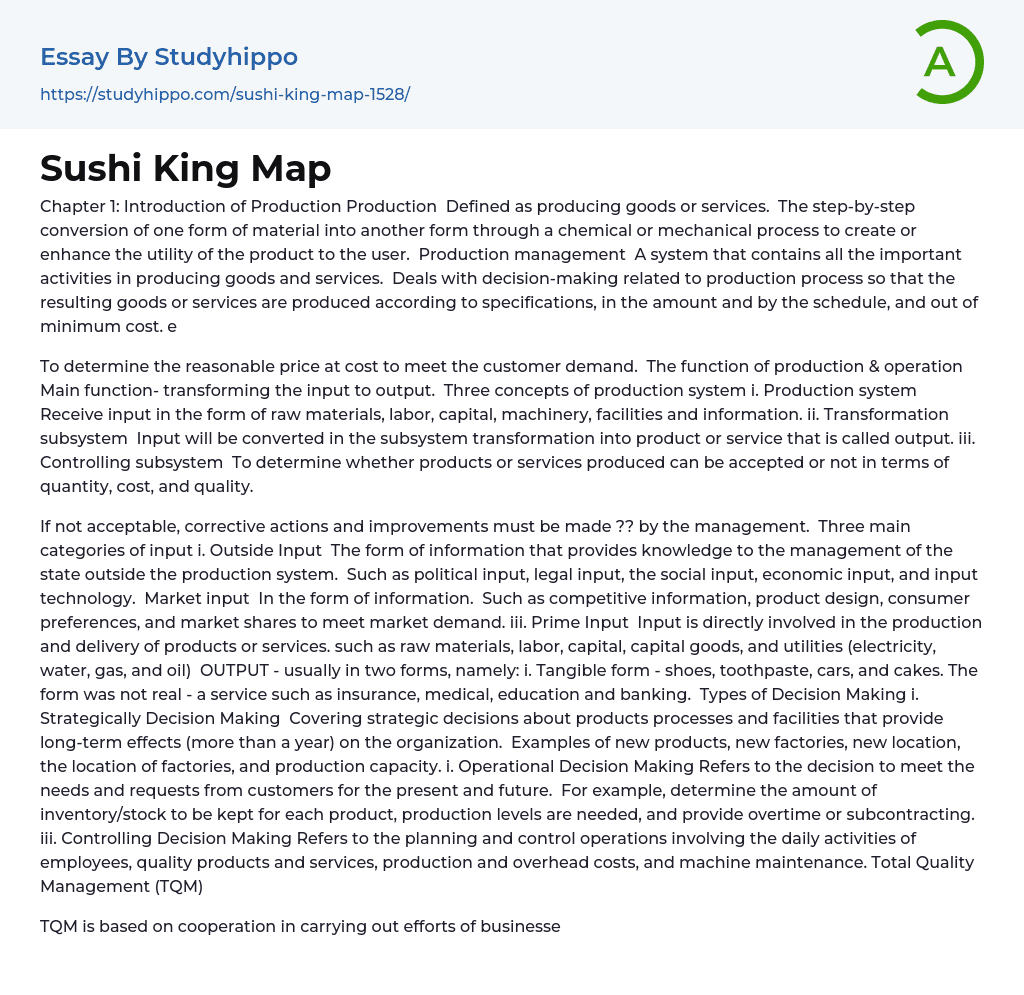Chapter 1: Introduction of Production Production Defined as producing goods or services. The step-by-step conversion of one form of material into another form through a chemical or mechanical process to create or enhance the utility of the product to the user. Production management A system that contains all the important activities in producing goods and services. Deals with decision-making related to production process so that the resulting goods or services are produced according to specifications, in the amount and by the schedule, and out of minimum cost. e
To determine the reasonable price at cost to meet the customer demand. The function of production & operation Main function- transforming the input to output. Three concepts of production system i. Production system Receive input in the form of raw materials, labor, capital, machinery, facilities and information. ii. Transformation subsy
...stem Input will be converted in the subsystem transformation into product or service that is called output. iii. Controlling subsystem To determine whether products or services produced can be accepted or not in terms of quantity, cost, and quality.
If not acceptable, corrective actions and improvements must be made ?? by the management. Three main categories of input i. Outside Input The form of information that provides knowledge to the management of the state outside the production system. Such as political input, legal input, the social input, economic input, and input technology. Market input In the form of information. Such as competitive information, product design, consumer preferences, and market shares to meet market demand. iii. Prime Input Input is directly involved in the production and delivery of products or services. such as raw materials, labor, capital, capital goods, and utilities
(electricity, water, gas, and oil) OUTPUT - usually in two forms, namely: i. Tangible form - shoes, toothpaste, cars, and cakes. The form was not real - a service such as insurance, medical, education and banking. Types of Decision Making i. Strategically Decision Making Covering strategic decisions about products processes and facilities that provide long-term effects (more than a year) on the organization. Examples of new products, new factories, new location, the location of factories, and production capacity. i. Operational Decision Making Refers to the decision to meet the needs and requests from customers for the present and future. For example, determine the amount of inventory/stock to be kept for each product, production levels are needed, and provide overtime or subcontracting. iii. Controlling Decision Making Refers to the planning and control operations involving the daily activities of employees, quality products and services, production and overhead costs, and machine maintenance. Total Quality Management (TQM)
TQM is based on cooperation in carrying out efforts of businesses that rely on the talents of comprehensive labor and management. TQM Principles 1. Customer focus Without customer, No business and loss income. 2. Leadership Leader or Manager can lead staff to the success of self-management and share knowledge. 3. Involvement of people The nature of ownership and pride to be part of the organization. responsible and willing to solve problems in teams Process approach Involves the work process in which individuals understand the process and their functions and relationships with customers. . System approach to management Understand the requirements of total Quality management. Continual Improvement Exist ideas, work patterns, and new technologies through research and development. Factual approach to decision-making Accurate data
and appropriate use. Decisions based on the study in accordance with personal experience and capacities. Mutually beneficial supplier relationships Transparency in communication. Five effective approaches of TQM Continuous improvement Empowerment Aware of the rivals Just In Time concept Knowledge of TQM materials
- Auction essays
- Balanced Scorecard essays
- Business Plans essays
- Expense essays
- Income essays
- Net Income essays
- Security Guard essays
- Singapore Airlines essays
- Battle essays
- Intranet essays
- Maintenance essays
- Simulation essays
- Inn essays
- Chief Executive Officer essays
- Convenience Store essays
- Firm essays
- Training And Development essays
- Unilever essays
- Variable Cost essays
- Virgin Group essays
- Bargaining essays
- Entity essays
- Pest analysis essays
- Child essays
- Childcare essays
- Child labor essays
- Doll essays
- Incentive essays
- Advertising essays
- Audience Theory essays
- Competitor Analysis essays
- Consumer essays
- Marketing Management essays
- Marketing Mix essays
- Marketing Plan essays
- Marketing Research essays
- Marketing Strategy essays
- Point Of Sale essays
- Price essays
- Procurement essays
- Product essays
- Product Differentiation essays
- Promotion essays
- Promotion And Marketing Communications essays
- Retailing essays
- Trademark essays
- Anheuser-busch essays
- Brands essays
- Detergent essays
- Product Placement essays




